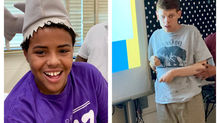A Day I’ll Never Forget: Understanding the Brain-Body Disconnect
- Anne Butler

- May 6
- 3 min read
About 15 years ago, I experienced something that forever changed my perspective as an educator. I was home with my two young children, ages 4 and 2, when a severe migraine struck.
Suddenly, the day I’d planned—full of play and laughter—shifted dramatically. As the pain intensified, I knew I needed to retreat to a dark, quiet room, but first, I had to communicate this change to my kids.
In my mind, I formed the simple sentence, “Let’s watch Max and Ruby.” But when I tried to speak, what came out was, “One, two, three.”
I was stunned. My thoughts were clear, but my words were not. I couldn’t make my body do what my brain was telling it to. This frightening disconnect led to a trip to the ER, where I learned my migraine had caused temporary aphasia—a disruption in my ability to process and produce language.
It wasn’t a stroke, but it was a powerful, disorienting experience.

A Glimpse Into Our Students’ Daily Reality
That moment of brain-body disconnect was brief for me, but for many autistic students, it’s a daily reality. My mind was sharp—I knew exactly what I wanted to say—but my body simply wouldn’t cooperate. The emotions I felt—frustration, confusion, fear—were overwhelming.
Yet, this is what many autistic students experience every day, not just for a few minutes, but throughout their whole lives.
As educators, we often see students who don’t follow instructions, who seem unresponsive, or who can’t complete tasks as we expect. Too often, we jump to the conclusion that they are unwilling, incapable, or not trying hard enough. But my experience taught me that what looks like non-compliance or lack of ability is often something much deeper: a brain-body disconnect.
Their minds may be fully engaged, understanding, and eager to participate, but their bodies don’t always respond as intended.

It’s Not a Lack of Cognition or Desire
This disconnect is not about intelligence or willingness. Just as I desperately wanted to communicate with my children during my migraine, our autistic students often want to engage, respond, and succeed. The challenge is not in their minds but in the complex pathways between thought and action.
When we assume a student’s difficulties are behavioral or cognitive, we risk undermining their confidence and missing out on their true potential. My brief struggle with aphasia helped me realize how vital it is to approach our students with empathy and patience. They are working through obstacles we may never fully understand.
Presume Competence—Always
What our students need most is for us to presume competence. When we believe in their abilities and support them through moments of disconnect, we empower them to keep trying. We create a classroom culture where students are respected for their efforts and strengths, not judged by their challenges.

A strengths-based, empathetic approach means:
Recognizing that a lack of response is not a lack of understanding or motivation.
Providing support and reassurance, just as I needed during my own moment of disconnect.
Creating opportunities for students to show their abilities in ways that work for them.

Building a More Inclusive Classroom
When we shift our perspective from “won’t do” to “can’t do—right now,” we open the door to more effective support and richer learning experiences. We stop seeing students as defiant or incapable and start seeing them as resilient individuals navigating a world that often doesn’t accommodate their needs.
By focusing on what students can do, and by being patient when their bodies don’t cooperate with their minds, we foster an environment where all learners can thrive. My brief experience with brain-body disconnect gave me a window into the daily lives of my students—and a renewed commitment to meet them with understanding, respect, and unwavering belief in their potential.
If you’d like to learn more about supporting non-speaking autistic individuals and building inclusive classrooms, I encourage you to explore the Communication for Education course. It offers practical strategies for presuming competence, supporting apraxia, and fostering true partnership between educators and students.

Anne Butler is a Communication Teacher at REV where she provides one-on-one communication instruction for students in our Gaithersburg and Annapolis locations.
























.png)

.png)



.png)


Comments